Notes: This station, authorised on 2 November 1893 at £1,080, replaced the North Eastern Railway’s first station which lay 11ch north – see Ryhope (1st) NER. It stood about 100yd west of the Londonderry Railway (Seaham & Sunderland Railway) station (later known as Ryhope East). Sinclair (1985) gives the opening date as 1894.
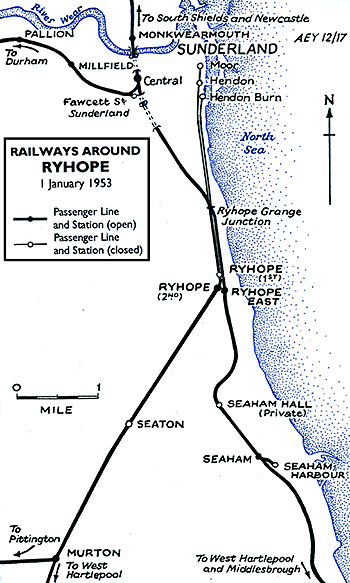 Ryhope station was immediately south-west of the bridge where Robson Place passed under the railway, having been diverted from crossing the line on the level. The station’s two facing platforms were about 210yd in length. The principal passenger building was on the down (Sunderland-bound) platform. Its design resembled that at Prudhoe (1884) consisting of a plain single-storey, brick-built structure under a slate pitched roof, with wings projecting onto the platform at each end. Between the wings was a verandah enclosed by a glazed, timber screen. The building contained the station offices and waiting rooms. On the opposite platform was a pent-roofed timber structure containing waiting and toilet facilities. At the north-east end of this platform was the stationmaster’s house, a dull two-storey affair in brick with a slightly overhanging pitched roof. Also at this end of the platforms was a standard, curved profile NER footbridge. This was a graceful design made up of cast iron parts which was erected on site. The castings were lettered and numbered to facilitate assembly. Regrettably, the original standard drawing for these bridges is undated, but they appeared at many NER stations in the late nineteenth century. Access to the footbridge was provided both from the platforms and the road side. Ryhope station was immediately south-west of the bridge where Robson Place passed under the railway, having been diverted from crossing the line on the level. The station’s two facing platforms were about 210yd in length. The principal passenger building was on the down (Sunderland-bound) platform. Its design resembled that at Prudhoe (1884) consisting of a plain single-storey, brick-built structure under a slate pitched roof, with wings projecting onto the platform at each end. Between the wings was a verandah enclosed by a glazed, timber screen. The building contained the station offices and waiting rooms. On the opposite platform was a pent-roofed timber structure containing waiting and toilet facilities. At the north-east end of this platform was the stationmaster’s house, a dull two-storey affair in brick with a slightly overhanging pitched roof. Also at this end of the platforms was a standard, curved profile NER footbridge. This was a graceful design made up of cast iron parts which was erected on site. The castings were lettered and numbered to facilitate assembly. Regrettably, the original standard drawing for these bridges is undated, but they appeared at many NER stations in the late nineteenth century. Access to the footbridge was provided both from the platforms and the road side.
It is not certain who was stationmaster when this station opened, but it was possibly Mr R Lumley who transferred to Beamish from Ryhope on 3 December 1903. On the same date the stationmaster at neighbouring Ryhope East left his post and henceforth both stations were administratively treated as one, sharing a stationmaster, and their bookings statistics appear to have been combined. On 3 December 1903 Thomas Lish moved from his stationmaster’s post at Leadgate to take on this role at Ryhope which he held until 20 February 1925.
NER records reveal that in 1911 the Ryhope stations served 11,236 people and issued 138,568 tickets. The goods traffic (handled in sidings placed between the diverging tracks of the former D&S and Londonderry routes) in 1913 amounted to 1,476 tons of scrap iron and steel and 27 vans of livestock. The RCH Handbook (1904) refers to a 1-ton 10cwt capacity crane and sidings serving Ryhope Colliery & Brickworks and Silksworth Colliery & Depot. There was no goods warehouse at the station.
The October 1912 timetable shows a more frequent service on Saturday than on other weekdays; this feature would be seen in later timetables too. Since 1905 the new coastal route through Seaham and Horden provided a far more direct journey between Sunderland, West Hartlepool and Middlesbrough but it will be seen that the service via Ryhope was maintained. Two up trains are shown with Durham (Elvet) as their destination; Elvet replaced the original Durham terminus at Shincliffe (Town) in 1893. Passengers from Ryhope travelling to Durham would normally change trains for the branch at Murton.
October 1912
Up trains: weekdays |
Destination |
Down trains: weekdays |
Destination |
6.22am |
Durham (Elvet) |
5.54am MX |
Sunderland |
7.37am |
Stockton |
8.00am |
Sunderland |
9.22am |
West Hartlepool |
9.50am |
Sunderland |
10.50am |
West Hartlepool |
11.00am |
Sunderland |
12.39pm |
West Hartlepool |
12.05pm ¶ |
Sunderland |
1.53pm ¶ |
Haswell |
12.27pm SO+ |
Sunderland |
2.15pmSO+ |
Murton |
12.58pmSO+ |
Sunderland |
2.39pm |
West Hartlepool |
1.09pm |
Sunderland |
4.07pm |
West Hartlepool |
2.48pm ¶ |
Sunderland |
6.15pm SO+ |
West Hartlepool |
4.43pm |
Sunderland |
6.32pm |
West Hartlepool |
6.39pm |
Sunderland |
9.24pm SO+ |
Wellfield |
6.50pm |
Sunderland |
9.40pm |
West Hartlepool |
8.03pm |
Sunderland |
11.17pm SO |
Durham (Elvet) |
8.59pm |
Sunderland |
= |
- |
9.59pm |
Sunderland |
- |
- |
10.15pm |
Sunderland |
Up trains: Sunday |
Destination |
Down trains: Sunday |
Destination |
9.05am |
West Hartlepool |
8.31am |
Sunderland |
6.11pm |
West Hartlepool |
5.51pm |
Sunderland |
SO Saturday only SO+ Alternate Saturdays MX Monday excepted
¶ Steam Autocar
In January 1923 the North Eastern Railway lines became part of the new London & North Eastern Railway (LNER) at the ‘Grouping’. Stationmaster Lish was still in post at this time, supervising Ryhope and Ryhope East stations, but he retired on 20 February 1925. No record has been found of the date of appointment of Richard Wilkinson who was stationmaster until 31 December 1931, but it is possible that it was he who replaced Mr Lish. No details of stationmasters of the Ryhope stations have been found until the death in service of Mr H R Peacock in 1951; his date of appointment is not known.
 In 1931 the passenger service on the Durham (Elvet) branch was cut back to Pittington, although excursion trains (including the annual Durham Miners’ Gala specials) continued to be handled at Elvet station. The September 1937 timetable shows that a frequent weekday service of through trains from Sunderland now operates to Pittington (or to Hetton – the station before Pittington) and on weekdays the interval for much of the day is hourly, with a similar frequency of trains to West Hartlepool though at less regular intervals. Sunday train services are, however, sparse. The 1920s and ‘30s saw increased competition offered by road motor transport, notably buses in this area where car ownership was probably not high. In May 1931, for example, Northern operated a quarter-hourly weekday bus service between Sunderland and West Hartlepool (half-hourly on Sunday) and Sunderland District Omnibus Co provided hourly services every day. Northern also ran a half-hourly service between Sunderland, Ryhope, Murton, Haswell and Thornley – all with stations on the old Sunderland – West Hartlepool railway. Intending passengers enjoyed generous provision of public transport at this time. The notion of buses competing with the trains is somewhat misleading as the Railway (Road Transport) Act of 1928 was promoted by the four big ‘grouping’ railway companies to allow them to operate buses; and under a subsequent agreement made with existing bus interests, railway companies were permitted to acquire up to 50% of the shares in bus companies. The LNER took advantage of this and acquired a financial stake, for instance, in Northern and in Sunderland and District (who provided ‘competing’ buses – see above) as well as United. In 1931 the passenger service on the Durham (Elvet) branch was cut back to Pittington, although excursion trains (including the annual Durham Miners’ Gala specials) continued to be handled at Elvet station. The September 1937 timetable shows that a frequent weekday service of through trains from Sunderland now operates to Pittington (or to Hetton – the station before Pittington) and on weekdays the interval for much of the day is hourly, with a similar frequency of trains to West Hartlepool though at less regular intervals. Sunday train services are, however, sparse. The 1920s and ‘30s saw increased competition offered by road motor transport, notably buses in this area where car ownership was probably not high. In May 1931, for example, Northern operated a quarter-hourly weekday bus service between Sunderland and West Hartlepool (half-hourly on Sunday) and Sunderland District Omnibus Co provided hourly services every day. Northern also ran a half-hourly service between Sunderland, Ryhope, Murton, Haswell and Thornley – all with stations on the old Sunderland – West Hartlepool railway. Intending passengers enjoyed generous provision of public transport at this time. The notion of buses competing with the trains is somewhat misleading as the Railway (Road Transport) Act of 1928 was promoted by the four big ‘grouping’ railway companies to allow them to operate buses; and under a subsequent agreement made with existing bus interests, railway companies were permitted to acquire up to 50% of the shares in bus companies. The LNER took advantage of this and acquired a financial stake, for instance, in Northern and in Sunderland and District (who provided ‘competing’ buses – see above) as well as United.
September 1937
Up trains: weekdays |
Destination |
Down trains: weekdays |
Destination |
7.25am |
West Hartlepool |
7.54am |
Sunderland |
7.36am |
Pittington |
8.38am |
Sunderland |
8.27am # |
West Hartlepool |
10.02am |
Sunderland |
9.29am |
Pittington |
10.38am |
Sunderland |
9.42am |
West Hartlepool |
11.13am # |
Sunderland |
11.29am |
Pittington |
12.38pm |
Sunderland |
12.29pm |
Pittington |
12.59pm SO |
Sunderland |
12.52pm |
West Hartlepool |
1.34pm |
Sunderland |
1.29pm |
Pittington |
2.14pm SO |
Sunderland |
2.03pm # |
West Hartlepool |
2.40pm |
Sunderland |
2.29pm |
Pittington |
3.02pm # |
Sunderland |
2.45pm |
West Hartlepool |
3.38pm |
Sunderland |
3.29pm |
Pittington |
4.38pm |
Sunderland |
4.10pm |
West Hartlepool |
4.45pm |
Sunderland |
4.29pm |
Pittington |
5.38pm |
Sunderland |
5.14pm # |
West Hartlepool |
6.27pm # |
Sunderland |
5.29pm |
Pittington |
6.38pm |
Sunderland |
6.02pm SO |
West Hartlepool |
6.45pm |
Sunderland |
6.29pm |
Pittington |
7.43pm |
Sunderland |
6.43pm |
West Hartlepool |
8.34pm |
Sunderland |
7.29pm |
Hetton |
8.41pm |
Sunderland |
8.29pm |
Pittington |
9.38pm |
Sunderland |
9.04pm |
West Hartlepool |
10.02pm # |
Sunderland |
9.29pm |
Pittington |
10.38pm |
Sunderland |
9.43pm SO |
West Hartlepool |
11.19pm SX |
Sunderland |
10.02pm |
West Hartlepool |
11.32pm SO |
Sunderland |
10.29pm |
Pittington |
11.34pm SO |
Sunderland |
10.52pm SO |
West Hartlepool |
- |
- |
11.12pm SO |
Hetton |
- |
- |
Up trains: Sunday |
Destination |
Down trains: Sunday |
Destination |
9.22am |
West Hartlepool |
8.22am |
Sunderland |
5.42pm |
West Hartlepool |
5.27pm |
Sunderland |
SO Saturday only SX Saturday excepted # One class only
During World War 2 the Monday-to-Friday train service was curtailed, as seen below in June 1943 but, particularly on the Pittington branch, Saturday trains were reasonably frequent later in the day.
June 1943
Up trains: weekdays |
Destination |
Down trains: weekdays |
Destination |
7.19am # |
Pittington |
8.06am |
Sunderland |
7.32am # |
West Hartlepool |
8.31am # |
Sunderland |
11.29am SO |
Pittington |
9.58am # |
Sunderland |
12.37pm # |
Pittington |
12.41pm SO |
Sunderland |
1.07pm SX |
Haswell |
1.43pm # |
Sunderland |
1.07pm SO |
West Hartlepool |
1.49pm SO |
Sunderland |
1.35pm SO |
Pittington |
1.59pm SX |
Sunderland |
3.29pm SO |
Pittington |
2.42pm SO |
Sunderland |
3.37pm SO |
Castle Eden |
3.05pm SO |
Sunderland |
4.10pm SX |
Haswell |
4.41pm SO |
Sunderland |
5.19pm # |
Haswell |
5.04pm |
Sunderland |
5.29pm SX |
Pittington |
6.29pm # |
Sunderland |
5.40pm SO |
Pittington |
6.41pm SX |
Sunderland |
6.30pm SO |
Pittington |
6.43pm SO |
Sunderland |
6.42pm |
West Hartlepool |
7.41pm SO |
Sunderland |
7.36pm SO |
Hetton |
8.34pm |
Sunderland |
8.07pm SO |
West Hartlepool |
8.41pm SO |
Sunderland |
8.36pm SO |
Pittington |
9.47pm SO |
Sunderland |
9.42pm |
West Hartlepool |
11.43pm SO |
Sunderland |
10.30pm SO |
Pittington |
- |
- |
Up trains: Sunday |
Destination |
Down trains: Sunday |
Destination |
9.12am |
West Hartlepool |
8.02am |
Sunderland |
SO Saturday only SX Saturday excepted
After the war the enhanced Saturday train service to and from the Pittington / Hetton branch continued in summer 1946 but by winter 1947 fewer trains operated.
 On 1 January 1948 most of the railway network in Great Britain was nationalised as British Railways (BR) and the Ryhope stations were allocated to the North Eastern Region (NE). Mr H R Peacock is thought to have been stationmaster at this time. After his death in service on 23 June 1951 it is likely that he was succeeded by Mr H J Millett who held the post until December 1955 when he was transferred to Longwood & Milnsbridge. On 1 January 1948 most of the railway network in Great Britain was nationalised as British Railways (BR) and the Ryhope stations were allocated to the North Eastern Region (NE). Mr H R Peacock is thought to have been stationmaster at this time. After his death in service on 23 June 1951 it is likely that he was succeeded by Mr H J Millett who held the post until December 1955 when he was transferred to Longwood & Milnsbridge.
In an interesting turn of events the infrequent train service through Ryhope was boosted in 1949/50 on weekdays to an hourly departure for Hetton, with a few trains continuing to Pittington, and several trains to West Hartlepool, but there was no Sunday service. As before there were a few more departures on Saturday than on Monday-to-Friday.
June 1950
Up trains: weekdays |
Destination |
Down trains: weekdays |
Destination |
6.57am |
West Hartlepool |
8.05am |
Sunderland |
8.14am |
Pittington |
9.43am |
Sunderland |
9.25am |
Hetton |
10.43am |
Sunderland |
10.25am |
Hetton |
11.43am ‡ |
Sunderland |
11.25am |
Pittington |
12.43pm † |
Sunderland |
12.25pm |
Hetton |
12.57pm SO |
Sunderland |
12.50pm SO |
West Hartlepool |
1.43pm |
Sunderland |
1.25pm |
Hetton |
2.09pm ø |
Sunderland |
2.25pm |
Hetton |
2.43pm |
Sunderland |
3.25pm |
Hetton |
3.43pm |
Sunderland |
4.25pm |
Hetton |
4.46pm |
Sunderland |
5.14pm |
West Hartlepool |
5.43pm |
Sunderland |
5.25pm |
Pittington |
6.43pm |
Sunderland |
6.25pm |
Hetton |
7.43pm |
Sunderland |
7.00pm SO |
West Hartlepool |
8.32pm SO |
Sunderland |
7.25pm SO |
Pittington |
8.43pm |
Sunderland |
8.25pm |
Hetton |
9.43pm |
Sunderland |
9.25pm |
Hetton |
10.17pm SO |
Sunderland |
9.55pm SO |
West Hartlepool |
10.43pm |
Sunderland |
10.25pm SO |
Hetton |
- |
- |
SO Saturday only ‡ 3 minutes later on Saturday † 4 minutes later on Saturday
ø Train discontinued before 3 July 1950
This lavish service must not have attracted enough passengers as in September 1950 most of the trains ceased to run on Monday-to-Friday leaving an intensive Saturday-only service with few parallels elsewhere in British railway history; the Manors North-Newbiggin service, also in north-east England, had such a character from June 1959. The remarkable timetable, still in operation in winter 1951, is reproduced below:

Ryhope station retained an essentially Victorian character in British Railways’ days: electric lighting was not installed and BR signage never appeared. Having experimented with different levels of passenger service BR identified the Sunderland – Pittington and Sunderland – Wellfield – West Hartlepool lines as uneconomic. In 1951 the two Ryhope stations together issued only 6,917 tickets. The passenger service between Murton and West Hartlepool was withdrawn on 9 June 1952, although it was still incorrectly included in the summer 1952 timetable. The Sunderland – Pittington service continued for some months, but as seen on several of its loss-making lines in the early 1950s, BR(NE) closed one station (Seaton) shortly to be followed by the entire line; Menthorpe Gate, Ampleforth and Hampsthwaite stations in Yorkshire illustrate this feature. Passenger services were withdrawn from Seaton station on 1 September 1952 to be followed by the route from Ryhope Grange Junction to Pittington on 5 January 1953.
 The line through Ryhope remained busy with coal traffic and the station’s goods facility (shared with Ryhope East) continued to operate. Ryhope East was to remain open to passengers until 7 March 1960. On this date Ryhope goods was renamed Ryhope East and it eventually closed on 1 June 1964. Ryhope station had been demolished by 1977 with the exception of the footbridge. The line through the station was used by coal trains from Murton Colliery until the closure of this pit in November 1991; the date of track-lifting is not known. Today almost the entire former Ryhope Grange Junction – Wellfield – Hart (West Hartlepool) railway is a traffic-free cycle route, one of many old railway trackbeds in County Durham providing recreational rights of way. At Ryhope the distinctive NER footbridge is all that remains of the station, with staircases on the north-east side only. The line through Ryhope remained busy with coal traffic and the station’s goods facility (shared with Ryhope East) continued to operate. Ryhope East was to remain open to passengers until 7 March 1960. On this date Ryhope goods was renamed Ryhope East and it eventually closed on 1 June 1964. Ryhope station had been demolished by 1977 with the exception of the footbridge. The line through the station was used by coal trains from Murton Colliery until the closure of this pit in November 1991; the date of track-lifting is not known. Today almost the entire former Ryhope Grange Junction – Wellfield – Hart (West Hartlepool) railway is a traffic-free cycle route, one of many old railway trackbeds in County Durham providing recreational rights of way. At Ryhope the distinctive NER footbridge is all that remains of the station, with staircases on the north-east side only.
Route map drawn by Alan Young. Tickets from Michael Stewart
BIBLIOGRAPHY
- Clinker, C R Clinker’s Register (Avon Anglia, 1978)
- Hoole, Ken Regional history of the railways of Great Britain: Vol 4, the North East (David & Charles, 1974)
- Hoole, Ken Railway stations of the North East (David & Charles, 1985)
- Quick, Michael Railway passenger stations in Great Britain (RCHS, 2009)
- Simmons, Jack and Biddle, Gordon The Oxford companion to British railway history (Oxford University Press, 1997)
- Sinclair, Neil T Railways of Sunderland (Tyne & Wear County Council Museums, 1985)
See also: Ryhope (First site) & Ryhope East |



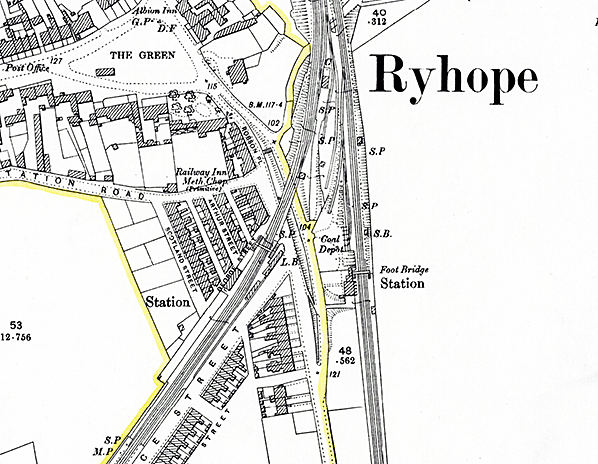
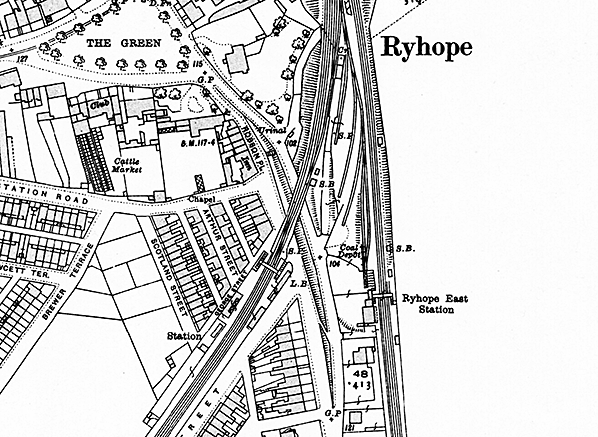

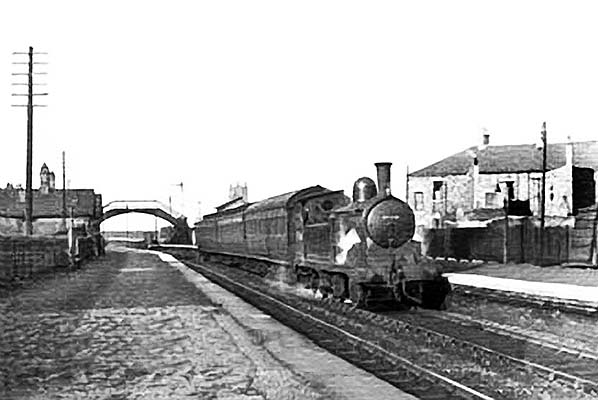


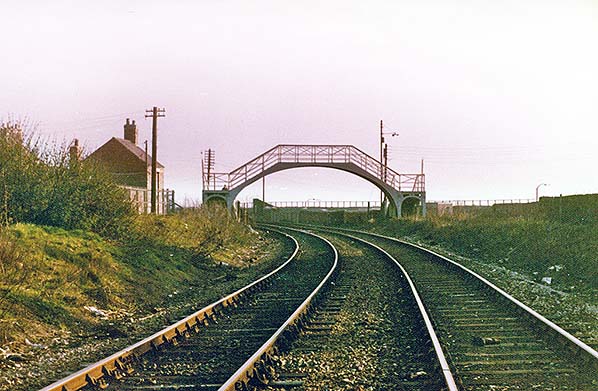
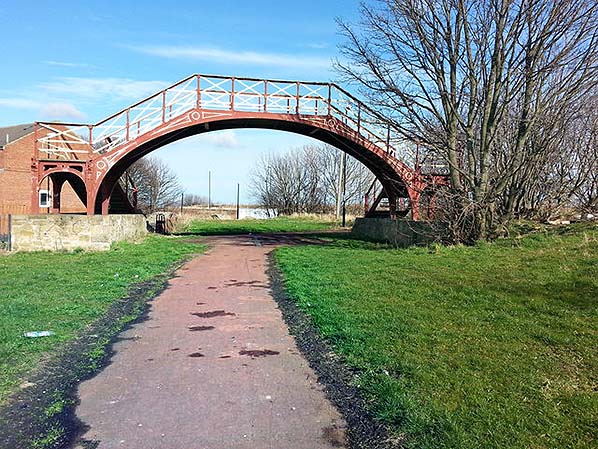

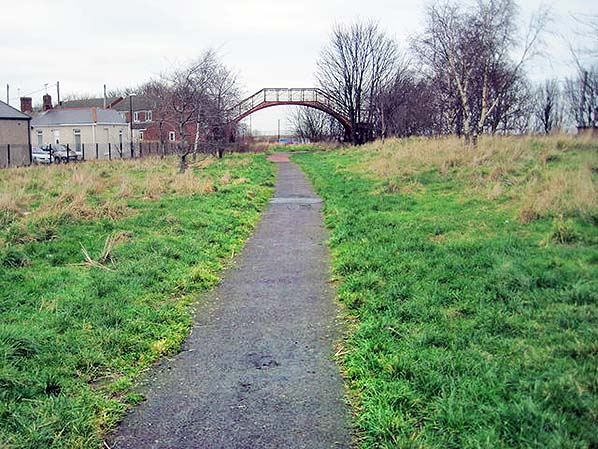
 Ryhope station was immediately south-west of the bridge where Robson Place passed under the railway, having been diverted from crossing the line on the level. The station’s two facing platforms were about 210yd in length. The principal passenger building was on the down (Sunderland-bound) platform. Its design resembled that at Prudhoe (1884) consisting of a plain single-storey, brick-built structure under a slate pitched roof, with wings projecting onto the platform at each end. Between the wings was a verandah enclosed by a glazed, timber screen. The building contained the station offices and waiting rooms. On the opposite platform was a pent-roofed timber structure containing waiting and toilet facilities. At the north-east end of this platform was the stationmaster’s house, a dull two-storey affair in brick with a slightly overhanging pitched roof. Also at this end of the platforms was a standard, curved profile NER footbridge. This was a graceful design made up of cast iron parts which was erected on site. The castings were lettered and numbered to facilitate assembly. Regrettably, the original standard drawing for these bridges is undated, but they appeared at many NER stations in the late nineteenth century. Access to the footbridge was provided both from the platforms and the road side.
Ryhope station was immediately south-west of the bridge where Robson Place passed under the railway, having been diverted from crossing the line on the level. The station’s two facing platforms were about 210yd in length. The principal passenger building was on the down (Sunderland-bound) platform. Its design resembled that at Prudhoe (1884) consisting of a plain single-storey, brick-built structure under a slate pitched roof, with wings projecting onto the platform at each end. Between the wings was a verandah enclosed by a glazed, timber screen. The building contained the station offices and waiting rooms. On the opposite platform was a pent-roofed timber structure containing waiting and toilet facilities. At the north-east end of this platform was the stationmaster’s house, a dull two-storey affair in brick with a slightly overhanging pitched roof. Also at this end of the platforms was a standard, curved profile NER footbridge. This was a graceful design made up of cast iron parts which was erected on site. The castings were lettered and numbered to facilitate assembly. Regrettably, the original standard drawing for these bridges is undated, but they appeared at many NER stations in the late nineteenth century. Access to the footbridge was provided both from the platforms and the road side. In 1931 the passenger service on the Durham (Elvet) branch was cut back to Pittington, although excursion trains (including the annual Durham Miners’ Gala specials) continued to be handled at Elvet station. The September 1937 timetable shows that a frequent weekday service of through trains from Sunderland now operates to Pittington (or to Hetton – the station before Pittington) and on weekdays the interval for much of the day is hourly, with a similar frequency of trains to West Hartlepool though at less regular intervals. Sunday train services are, however, sparse. The 1920s and ‘30s saw increased competition offered by road motor transport, notably buses in this area where car ownership was probably not high. In May 1931, for example, Northern operated a quarter-hourly weekday bus service between Sunderland and West Hartlepool (half-hourly on Sunday) and Sunderland District Omnibus Co provided hourly services every day. Northern also ran a half-hourly service between Sunderland, Ryhope, Murton, Haswell and Thornley – all with stations on the old Sunderland – West Hartlepool railway. Intending passengers enjoyed generous provision of public transport at this time. The notion of buses competing with the trains is somewhat misleading as the Railway (Road Transport) Act of 1928 was promoted by the four big ‘grouping’ railway companies to allow them to operate buses; and under a subsequent agreement made with existing bus interests, railway companies were permitted to acquire up to 50% of the shares in bus companies. The LNER took advantage of this and acquired a financial stake, for instance, in Northern and in Sunderland and District (who provided ‘competing’ buses – see above) as well as United.
In 1931 the passenger service on the Durham (Elvet) branch was cut back to Pittington, although excursion trains (including the annual Durham Miners’ Gala specials) continued to be handled at Elvet station. The September 1937 timetable shows that a frequent weekday service of through trains from Sunderland now operates to Pittington (or to Hetton – the station before Pittington) and on weekdays the interval for much of the day is hourly, with a similar frequency of trains to West Hartlepool though at less regular intervals. Sunday train services are, however, sparse. The 1920s and ‘30s saw increased competition offered by road motor transport, notably buses in this area where car ownership was probably not high. In May 1931, for example, Northern operated a quarter-hourly weekday bus service between Sunderland and West Hartlepool (half-hourly on Sunday) and Sunderland District Omnibus Co provided hourly services every day. Northern also ran a half-hourly service between Sunderland, Ryhope, Murton, Haswell and Thornley – all with stations on the old Sunderland – West Hartlepool railway. Intending passengers enjoyed generous provision of public transport at this time. The notion of buses competing with the trains is somewhat misleading as the Railway (Road Transport) Act of 1928 was promoted by the four big ‘grouping’ railway companies to allow them to operate buses; and under a subsequent agreement made with existing bus interests, railway companies were permitted to acquire up to 50% of the shares in bus companies. The LNER took advantage of this and acquired a financial stake, for instance, in Northern and in Sunderland and District (who provided ‘competing’ buses – see above) as well as United. On 1 January 1948 most of the railway network in Great Britain was nationalised as British Railways (BR) and the Ryhope stations were allocated to the North Eastern Region (NE). Mr H R Peacock is thought to have been stationmaster at this time. After his death in service on 23 June 1951 it is likely that he was succeeded by Mr H J Millett who held the post until December 1955 when he was transferred to Longwood & Milnsbridge.
On 1 January 1948 most of the railway network in Great Britain was nationalised as British Railways (BR) and the Ryhope stations were allocated to the North Eastern Region (NE). Mr H R Peacock is thought to have been stationmaster at this time. After his death in service on 23 June 1951 it is likely that he was succeeded by Mr H J Millett who held the post until December 1955 when he was transferred to Longwood & Milnsbridge.
 The line through Ryhope remained busy with coal traffic and the station’s goods facility (shared with Ryhope East) continued to operate. Ryhope East was to remain open to passengers until 7 March 1960. On this date Ryhope goods was renamed Ryhope East and it eventually closed on 1 June 1964. Ryhope station had been demolished by 1977 with the exception of the footbridge. The line through the station was used by coal trains from Murton Colliery until the closure of this pit in November 1991; the date of track-lifting is not known. Today almost the entire former Ryhope Grange Junction – Wellfield – Hart (West Hartlepool) railway is a traffic-free cycle route, one of many old railway trackbeds in County Durham providing recreational rights of way. At Ryhope the distinctive NER footbridge is all that remains of the station, with staircases on the north-east side only.
The line through Ryhope remained busy with coal traffic and the station’s goods facility (shared with Ryhope East) continued to operate. Ryhope East was to remain open to passengers until 7 March 1960. On this date Ryhope goods was renamed Ryhope East and it eventually closed on 1 June 1964. Ryhope station had been demolished by 1977 with the exception of the footbridge. The line through the station was used by coal trains from Murton Colliery until the closure of this pit in November 1991; the date of track-lifting is not known. Today almost the entire former Ryhope Grange Junction – Wellfield – Hart (West Hartlepool) railway is a traffic-free cycle route, one of many old railway trackbeds in County Durham providing recreational rights of way. At Ryhope the distinctive NER footbridge is all that remains of the station, with staircases on the north-east side only.
 Home Page
Home Page